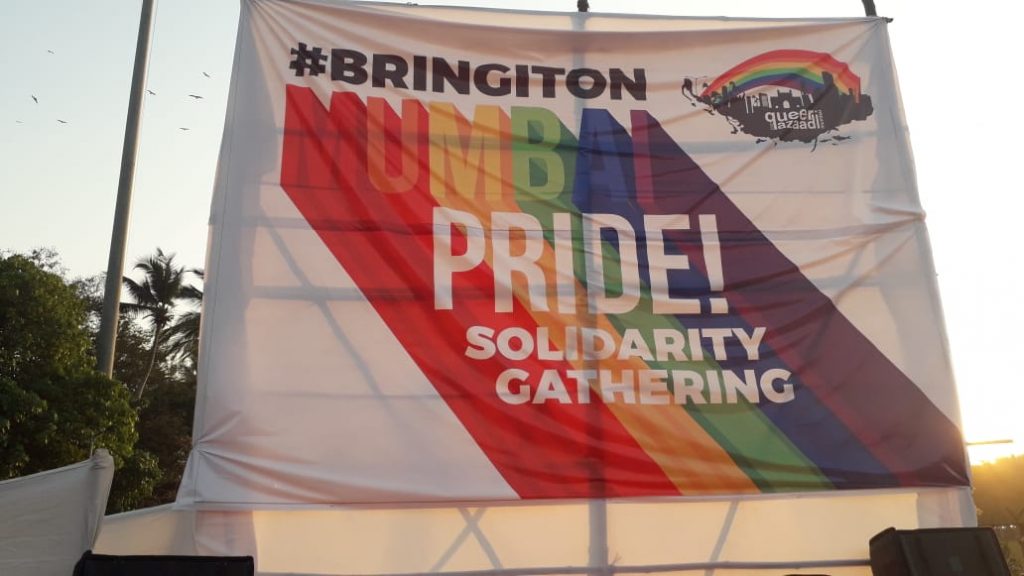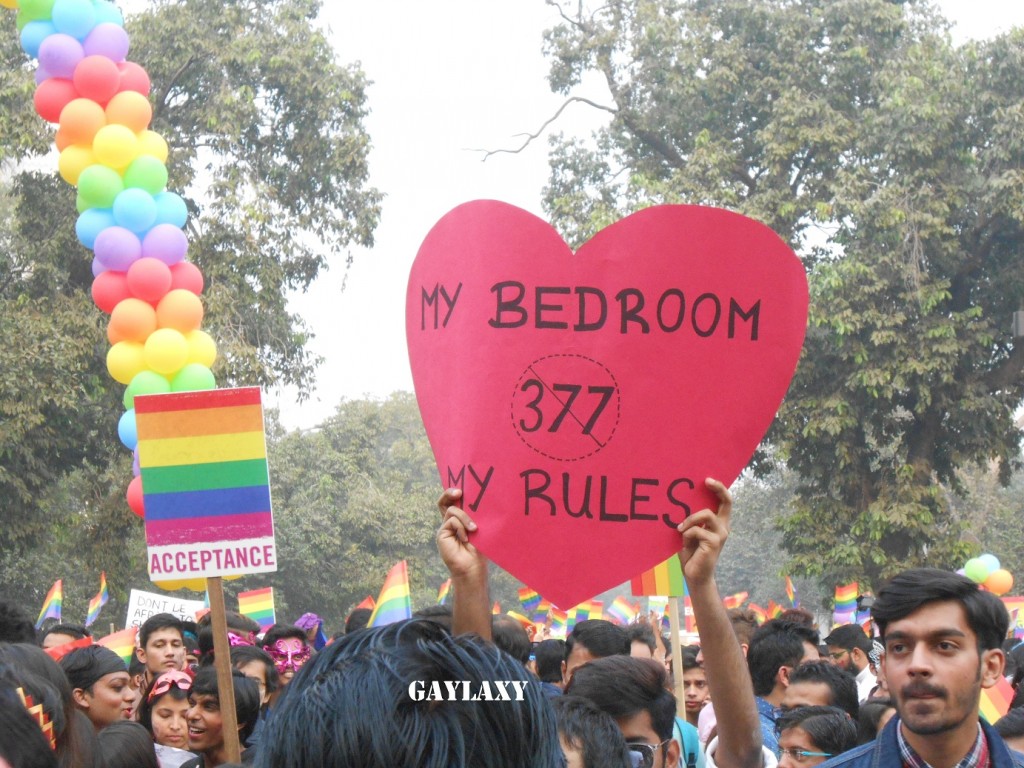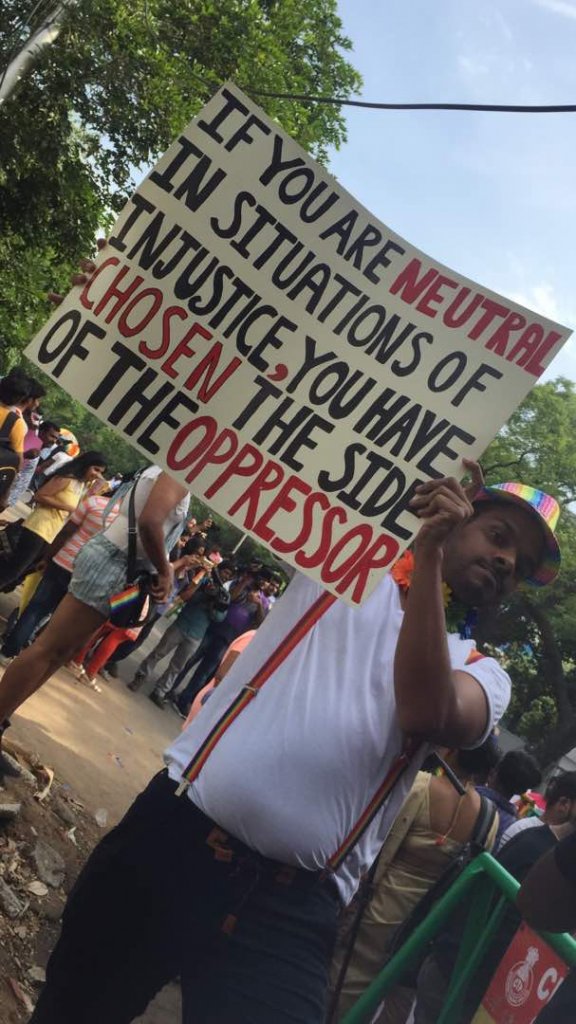The recent verdict by the Supreme Court with regards to Marriage Equality reaffirms the need to radically reimagine the thrust for Queer Emancipation and must push us to question the structures of Family, Law and The State.
——-
On April 17th, 15 transgender persons and rights activists who were peacefully protesting at the M Karunanidhi Memorial on the Marina in Chennai were manhandled and detained by the Tamil Nadu Police. They were there to demand horizontal reservation for the transgender community within education and public employment. On the same day, the Supreme Court was hearing a case regarding Same-Sex marriage legalisation filed by 15 petitioners while the Central Government filed its statement terming the demand as “an urban elitist concept”. The protestors in Chennai were ushered into buses and dropped off far away while news outlets extensively covered the court proceedings that carried on.
The Queer Liberation movement in India is at a watershed moment in history but it also risks navigating a fine line that could devolve into a diffused, depoliticised entity that gives benefits to the most privileged amongst us, while leaving the majority of the queer community adrift. Following the reading down of Section 377 by the Supreme Court in 2018, one is left to wonder about its repercussions in ground reality. The same cops that manhandle queer men cruising in cities or harass trans people elsewhere continue on with their jobs while the same material realities that many queer individuals across the country face remain mostly unchanged, and have even deteriorated because of the pandemic. One striking difference is probably the increasing boldness that corporate brands have in including Queer representation in advertisements. To them, this is a community that can be commodified, advertised and have products sold to – the Pink Rupee of the Affluent Indian Queer was rising in market value afterall.
Queer solidarity beyond the Binaries

The Mainstream LGBTQ Movement in India faces a question of existential relevance; whether to prioritize assimilating into systems of oppression that will give trickle-down benefits to its members – reaching the most vulnerable of us last, or whether to push for radical, intersectional solidarity and structural change. We already see this happening with the depoliticisation of Pride Marches happening across the country. In the Mumbai Pride Parade immediately following the civil unrest regarding the NRC-CAA protests and the abrogation of Article 370 that revoked state autonomy of Jammu and Kashmir, participants were instructed not to “allow political messaging or placards”. This hints at an insecure State apparatus that does not want liberation struggles like the Queer movement to stand up in solidarity for other oppressed communities in the country. By sectioning, dividing, censoring and depoliticising Pride, it transforms the space into one that is purely for aesthetic purposes that benefits the “respectability politics” of the upper-caste cisgender folks who are part of the community. In other Pride marches, flags bearing the Ambedkarite flag were asked to be removed because they were “too political”. Queer spaces across the country are increasingly being gatekept from the less affluent and marketed as places of aesthetics and performance as opposed to active politics and resistance.
The Queer Liberation movement in India is at a watershed moment in history but it also risks navigating a fine line that could devolve into a diffused, depoliticised entity that gives benefits to the most privileged amongst us, while leaving the majority of the queer community adrift.
Queerness has and always will transcend the borders of a nation-state, but the efforts to tap into this international solidarity are glaringly absent. When Pakistan’s Islamic Court struck down one of the most progressive Transgender Legislations in the world, there were barely any calls for lending solidarity across the subcontinent, emanating from the Queer community in India. As the world witnesses the Israeli Occupation and Genocide of Palestine, Queer movements across the world voice solidarity for Palestine, but back home protests by student and minority groups are met with detentions and arrests. How far-fetched is it for the Indian Queer Movement to also hold solidarity with an oppressed people drawing from the strong history of the subcontinent’s tryst with anti-imperialism and decolonisation? If we are to reach out to minority communities to further our rights, do we not have to cross the aisle, find common ground and combine struggles? On the contrary Queer politics, and the Same-Sex marriage litigation that has been going on in the Supreme Court in particular, has been one area that converges exclusionary, fundamentalist and queerphobic elements that plague this country. All major religious denominations, along with state governments ruled by parties from across the political spectrum and the Central Government regurgitated the same conservative talking points of opposing marriage equality: “traditional marriage structures”, “religious beliefs” and “preserving the sanctity of the family”. This is one area that Unity in Diversity truly shines on, displaying the eclectic mix of solidarity our country can indeed offer.
Queer spaces across the country are increasingly being gatekept from the less affluent and marketed as places of aesthetics and performance as opposed to active politics and resistance.
Homonationalism and The State
While the country grapples with increasing attempts at rewriting its history, efforts made to install a Hindu Rashtra, growing religious majoritarianism and diminishing democratic freedoms, it has found a way to co-opt Queer politics through ‘Homonationalism’. Organizations such as The Queer Hindu Alliance and other bodies advocate for the furthering of LGBTQIA+ rights but based on the premise that while “Hindu scriptures” have always been accepting of queer rights, it is the foreign, imported “Abrahamic religions” that spread homophobia and deter calls for societal integration. We see this when The Queer Hindu Alliance celebrated the abrogation of Article 370 saying it will benefit the Queer community of J&K but ground reality said otherwise. The pinkwashing of human rights abuses is further propounded and absorbed as queer politics is weaponised as a means to promote majoritarianism. This rhetoric thus serves as a dog whistle to further alienate religious minorities from the Queer Liberation Movement and promote the hegemony of Hindu, Savarna “Good Queers” of the nation-state.

The striking down of Section 377 that decriminalized Homosexuality was based on legal precedent from the 2017 Right to Privacy verdict. However, by grounding Decriminalisation on the basis of privacy, it ignored the notion that ‘privacy’ is often a luxury. The entire rhetoric of “the state should not intervene within the four walls of your room” assumes that you have a room to begin with. Queerness is not always within the privacy of one’s home; it is in the streets, in the railway stations, cruising parks, movie theaters and other spaces. Spaces that crouch beyond CCTV state-surveillance and are unmonitored by the mores of a conservative society dealing with a deep-rooted colonial hangover.
This brings us to the current conversation dominating the discourse of the Queer liberation movement in India. If the only changes made is switching the words “man and woman” to “spouse” in an effort to make the Special Marriages Act gender neutral, it still allows for the state to carry on as usual without passing effective institutional change to target the structural violence at the root of most queer communities. The State has weaponised the language of the cisheteronormative neoliberal family structure and the institution of marriage to deny inclusion of queer communities: it is this very structure and its norms that need to be evaluated and disrupted. What is the guarantee that state-sanctioned same-sex marriages won’t just propound the same caste endogamy that has been so endemic to Indian Society? Even the first gay Indian matrimonial newspaper ad had the phrase “same caste preferred” afterall. What we need is a radical and progressive understanding of family, rights and emancipation. We need not look far, Cuba had recently passed an instrumental Family Code through a referendum that sought to democratize the institution of the family and expanded rights for LGBT+ people, recognition of women’s household work and strong measures against gender violence and child protection.
Expanding the lexicon of Queer Rights

We must keep in mind that the Queer Liberation Movement does not and should not have its end goal in just ushering in same-sex marriage unions that will only immediately benefit monogamous, cisgender mostly upper-caste, urban, upper-class homosexuals. This article is not to discredit the merits of the highest constitutional court recognising same-sex unions. Of course that is exceptionally important. It will enable a conversation for furthering queer rights, and offer a legal precedent to protect queer couples. But for how long? Co-opting into a system of oppression advantages the most privileged of us and leaves the rest of us begging for scraps. Many of us might feel dejected, disappointed and enraged at the current Supreme Court verdict but we must channel this frustration and rage into larger discourses of the community and sustain the struggle. Efforts for queer emancipation must be directed towards grassroots level mobilization and access to education, housing, healthcare, transgender rights and a radical reimagination of spaces, communities and politics; the way our cities and towns are designed, access to public spaces, combating gentrification, standing firm against the corporatisation of Pride, calling for better working conditions, access to mental health resources, public distribution systems through single-person ration cards and so much more. Legal instruments to affirm queer identities are still missing. Horizontal reservation must be implemented to ensure that not all members of the Transgender community are roped under a single ‘OBC quota’. We require an Anti-Discrimination Law that encompasses non-cisgender/heterosexual identities. Laws must be passed to protect, specifically for LBTQ individuals who are victims of ‘natal family violence’ while recognising chosen families. Conversion therapy still continues across the country, as seen witnessed in Kerala, and a bottoms-up approach that sensitizes healthcare workers and institutions is the need of the hour. The mayor of Kochi recently passed an order to restrict timings of the popular city promenade: “Marine Drive” from only 5AM-10PM, which shows that public spaces of queer expression are shoved under the carpet to cater to the palettes of gentrified neighborhoods to be ‘family-friendly’. We must build solidarity with religious minority communities and queer folks within them leading to grass-roots constructive change like how a Kerala Church laid the ground for the country’s first transgender school to be built. The Queer community is not a monolith. Its struggle has to be interwoven with the struggle against fascism, hindutva majoritarianism, brahmanical patriarchy, queerphobia, poverty, state-sponsored oppression, minority disenfranchisement and the increasing marginalization of dispossessed communities in the country while creating solidarities with feminist movements, labour unions, student organisations, the anti-caste movement and transcend narrow categories of identity-politics.
We must keep in mind that the Queer Liberation Movement does not and should not have its end goal in just ushering in same-sex marriage unions that will only immediately benefit monogamous, cisgender mostly upper-caste, urban, upper-class homosexuals.
Countering the ‘Privatisation of Desire’
Ironically, the one entity that might benefit from the legalisation of same-sex marriage will be the Indian Government and the Capitalist cisheteronormative establishment. By allowing for Marriage Equality, it might satiate the demands of Savarna, Bourgeoise Queer folks who, now content with their inclusion into the system, will either wither away in diverting resources for a larger overhaul in the way systems work or shift focus to lighter demands. Because ultimately, marriage equality legitimizes the institution of marriage and assumes that “marriages” are inherently “equal” themselves. The Regime will now not have to fear an incessant social movement that tries to raise issues that hint at human rights abuses happening elsewhere in the country. Or atleast, that’s what it hopes for.
The majority judgment of the Supreme Court case has stated that while queer identities are valid and have to be respected: any law to include them in state-sanctioned institutions cannot be altered by the court but must be passed by the legislature, effectively passing the buck, and the future of queer rights in the country, to a majoritarian government that propounds Hindutva nationalism. While the RSS Chief Mohan Bhagwat has recently said that “LGBTQ people should have their own private and social space”, it is this very ‘privatization of expression and desire’ that is problematic; the Sangh Parivar is not and will not be the bearers of Queer Liberation. Ironically then, it is the very same homonationalists, the mostly savarna cisgender homosexual men of the community who tend to be allied with the ruling regime, who now have the greatest leverage to push for queer rights allowing for the possibility of further exclusionary rhetoric. This cannot happen at the risk of losing sight of the values of the Queer Liberation Movement such as intersectionality and solidarity with other minority and marginalised communities. Citing the separation of the judiciary and the legislature while saying that the court can only ‘interpret’ the law; the Supreme Court has washed off all obligations to safeguard the rights of the Queer community while offering piecemeal words of sympathy that sound like ‘Born This Way’ lyrics. CJI DY Chandrachud has said that the police must not harass queer people on the basis of sexuality or gender identity; how much this will go on to affect the structural violence that Queer Dalit, Adivasi, Bahujan and working class individuals face from the Institution of the Police everyday is left to be seen. In their article, “Imperialism at the Wheels: Re-evaluating the Indian Queer Movement”, Shri Rishi writes that: “In the struggle for legal recognition, one fails to notice that the fight was merely to seek legal approval for a specific form of desire led by a gallery of rich gay men while serving as a symbolic victory for the queer movement. This politics is not only for the bourgeois but serves to hide the class violence meted out against most of the queer population in India on a daily basis.”
Citing the separation of the judiciary and the legislature while saying that the court can only ‘interpret’ the law; the Supreme Court has washed off all obligations to safeguard the rights of the Queer community while offering piecemeal words of sympathy
Decolonising Queerness in a Neoliberal world
The struggle against Queerphobia must incorporate the struggle against neocolonialism and capitalism. It is an irony that the same right-wing traditional nationalists at the forefront against Queer rights, are now espousing an institution that was borne of colonial victorian morality laws and repression, whether it be Section 377, the Criminal Tribes Act of 1871 or the gross invisibilisation of indigenous expressions of queerness as featured in Khajuraho’s stone temples and mythologies of the subcontinent. To purely copy the vocabulary and approach of western-led queer movements risks disassociating from the larger sections of the queer community who don’t have the social capital to identify under these labels and ideals. Tamil Nadu, for example, has seen the popularisation of the words ‘Thirunangai’ and ‘Thirunambi’, and the umbrella term ‘Thirunar’ to refer to the Transgender community reclaiming vocabulary and language while recognising ‘Self-Respect’ marriages built on the Dravidian movement led by Periyar which has allowed for a more nuanced lexicon to take root. Chennai Pride was also renamed to the ‘Chennai Rainbow Pride and Self-Respect March’, using the term “Suyamariyathai” or Self-Respect built on the Periyar movement to accommodate marginalised identities. The same rationalist ideology that right-wing idealogues have tried to vilify in recent times.

The commodification of queer identities brought about with globalisation and an increasingly consumeristic culture has led to the class interests of the Affluent Queer being prioritized over others; it is not liberation when Pride Open Mics can be hosted in gleaming new Queer Cafes and Hotels that are built on land displacing slums and marginalised communities. In April 2023, India’s biggest aluminium producer Vedanta announced that it had recruited its first batch of transgender employees and currently has 20 transgender professionals working in Jharsuguda, Odisha and Balco, Chhattisgarh. It is also the same company that is looking to now expand Bauxite mining in Sijimali, Odisha and just last week held a public hearing that saw paramilitary troops repress protests by Adivasi groups against fears that it will negatively impact the 18 revenue villages that fall under the project. Corporate India cannot substitute systemic oppression of marginalised communities by announcing that its workforce is now ‘more diverse’ and therefore all is well.
The fight for Queer Liberation cannot be done purely through the courts and amicable panel discussions. It requires active resistance politics, mobilization and confrontation from all fronts.
On the other hand, the ‘homonationalistic’ line of assimilationist politics might also just lead to increased marginalization and structural violence to be meted to minority groups in the pursuit of ‘rights for most but not all’. The verdict is clear in one thing: the fight for Queer Liberation cannot be done purely through the courts and amicable panel discussions. It requires active resistance politics, mobilization and confrontation from all fronts. The Marriage Equality case will now be on the backburner and might at best take the form of a parliamentary committee to look into it. The time and resources of the community in the meanwhile should not sequester, but be channeled into other issues affecting the community more tangibly. While this might seem to dampen the spirits of some of us, we must look at it as an opportunity to reorient it in a way to strengthen solidarities, dissent and communities.
The Queer liberation movement in India must be prepared to weather all storms while also holding solidarity with the spirit of dissent and resistance that other social movements in the nation are pushing for. True emancipation does not arise when only the most privileged celebrate their rights, it happens when we ensure society allows its people to reach their full potential unhindered – because “Injustice anywhere is a threat to justice everywhere”.
This article was first published on Feminism In India
- Marriage Equality Should Not Be The End of Queer Liberation - December 21, 2023

